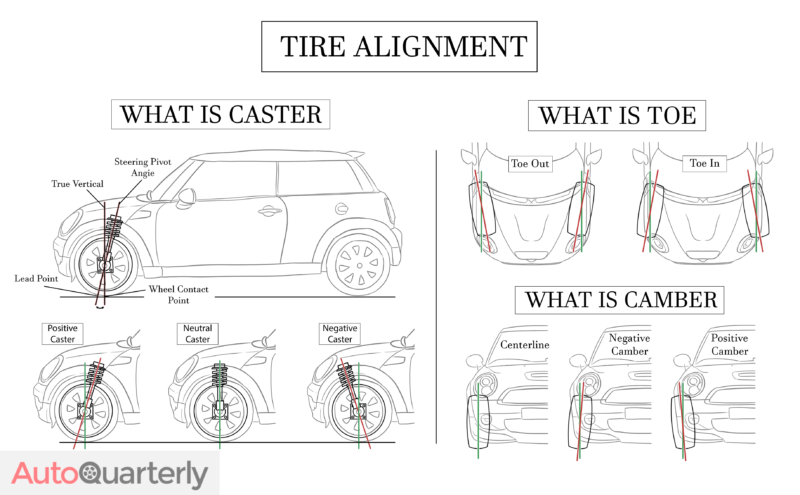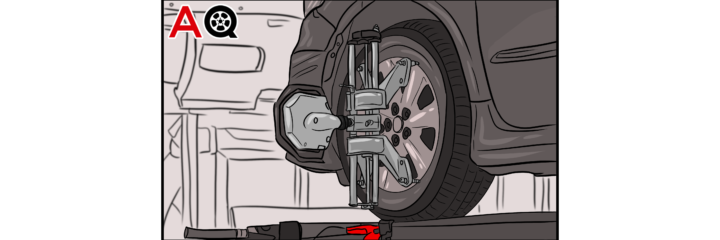Cars, trucks, and other personal four-wheeler vehicles are much easier to buy now than at any other point in history. Commuting and personal transportation have become so convenient that, perhaps, we take the luxury for granted.
One thing no car owner takes for granted, though, is vehicle maintenance. As most will testify, the drip-drip of vehicle maintenance costs can add up to substantial amounts on your end-of-the-year personal balance sheet.
In this piece, we’ll go through the basics of wheel alignment: what it is, when you need to go for one, best practices for wheel alignment, and the ballpark service costs for different vehicle types.
What Is a Wheel Alignment?
Simply put, wheel alignment involves the readjustment of the angle of a vehicle’s wheels in relation to its body and steering wheel, following the concerned vehicle manufacturer’s specifications.
Contrary to popular knowledge, the procedure isn’t carried out on the wheels themselves, but actually on the suspension. The vehicle’s suspension is adjusted so that its wheels make proper contact with the road. Watch this video for a visual representation of the entire process.
What Purposes Does a Wheel Alignment Serve?
While it is easy to see the benefits of wheel alignment as correcting the problems that created the need in the first place, it goes beyond that. Outside of resolving an off-center steering wheel, vibrating tires, and the uneven wear on each tire, some other benefits to proper wheel alignment include:
Accident Prevention
Aligning your tires on time could mean the difference between life and death. When tires wear unevenly (such as is the case with “feathering”), there is an increased chance of skidding at high speeds.
Increased Fuel Efficiency
When wheels are properly aligned, they function more efficiently and make correct contact with the tarmac.
Mitigating Expensive Repairs
With automobiles, one ignored root problem usually leads to even worse resulting problems. When wheels are misaligned, faults begin to crop up in the suspension and chassis.
Extended Tire Life
Lastly, aligning your wheels regularly makes both the wheels themselves and the tires last longer, preventing expensive and unnecessary tire changes.
When Do You Need a Wheel Alignment?
For most people, deciding when to take their cars in for alignment is tricky. Because misaligned wheels do not show up superficially, many of us are prone to procrastinating when it comes to this corrective maintenance procedure.
While some mechanics will prescribe one wheel alignments per year, Bridgestone, among others, advises that you look out for one or more of these signs at all times:
- Your steering wheel is in an off-center position even when you drive straight.
- Your vehicle keeps spontaneously veering to the left or right.
- You notice the presence of uneven wear on the tires.
- You find that the steering wheel or the vehicle itself continues to vibrate while driving
If you spot any of these signs, make sure to take your vehicle in for a wheel alignment.
How Much Do Wheel Alignments Cost?
A wheel alignment is among the cheapest service repairs on the price list of most auto shops. In fact, the average yearly cost of wheel alignments makes up less than 15% of the total vehicle maintenance costs. As long as you don’t have any other accompanying issues with the vehicle and it has a conventional design, a regular alignment should cost anywhere from $75-150 on average – depending on the model and vehicle type.
The figure above is just an average and does not narrow down the exact cost of the service. In addition, most repair shops offer a free alignment check to give you an idea of how urgently your vehicle needs an alignment (or to get a down payment out of you faster).
Will My Insurance Cover a Wheel Alignment
If another driver hits you, most insurance providers usually cover the cost of the resulting wheel alignment as required by the policy. However, insurance providers are not obligated to cover routine alignments as part of general vehicle maintenance.
It is important to note that most routine alignment procedures end up being paid for out of pocket, as they rarely meet the deductible threshold.
Watch Out for Mechanics Who Will Suggest Unnecessary Services
Crucially, always make sure to check for the credibility of any auto repair shop before you hand over your vehicle for alignment (or any other service at all). An ASE certification usually means that the mechanic is qualified to carry out the service properly. Also, make sure to get an outside opinion if the mechanic or body shop tries to up-sell you on other services that drive up the service cost.
Possible Kinds of Wheel Alignments

Wheel misalignment is not a homogenous problem, and neither is the approach to correcting it. When you take your vehicle in for a service, the technician in charge of wheel alignment checks for three parameters:
The Toe
The extent to which the front tip of a vehicle’s tire veers inward or outward when seen from above is the toe. As a common example that most engineering and automotive care websites would give, look down at your toes and tilt them inwards or outward. The inward tilt on a wheel is known as “toe-in” alignment while the outward tilt is known as “toe-out” alignment. Both are problematic and require a wheel alignment to correct.
The Caster
Basically, the caster is the axis on which the center of your tire rests. An optimum caster angle should be at the center of the wheel arch. A positive caster occurs when the axis tilts towards the driver’s side while a negative caster tilts towards the front of the vehicle. Either situation, just as with the toe, will require a wheel alignment to correct.
The Camber
The camber of a wheel is the inward or outward tilt of the top of a vehicle’s tires when viewed from the front. Positive camber is an inward tilt while a negative camber is an outward tilt. This is the most common type of wheel misalignment and is usually caused by worn-out ball joints, bearings, or other suspension parts.
The Difference Between Wheel Alignment and Wheel Balancing
Wheel alignment and wheel balancing commonly get confused with each other. However, these two are different both in concept and in practice. Wheel balancing focuses on weight imbalances in the tire/wheel unit. With wheel balancing, a technician either corrects or compensates for weight to add stability to the vehicle.
Despite the differences between wheel balancing and alignment, service centers and auto body shops usually lump them both into a single package. If you’re asking, why do I need wheel balancing? Well, it comes with its own separate set of advantages. Chief of them is the fact that balanced tires last and perform at an optimum level longer.
When Is Wheel Balancing Needed?
Basically, there are two kinds of wheel imbalances that would require servicing – static and dynamic imbalances. Static imbalance occurs on a single plane because of vertical movements that can cause unwanted vibrations. A dynamic imbalance, on the other hand, addresses two separate planes simultaneously – the vertical and lateral planes.
How Is Wheel Balancing Performed?
Usually, a technician starts the balancing process by mounting the tires on adequate rims and adjusting each tire’s pressure and inflation. Each tire is then placed on the center bore section of a balancing machine. The machine spins the rim holding the tires at high speeds and, using advanced motion-sensing hardware and internal algorithms, figures out how much weight needs to be added to the tire and where in particular the weight is needed.
Other Vehicle Maintenance Services You Might Need
When you take your vehicle to the repair shop for a routine alignment, it presents an opportunity for the mechanic to check for other faults that may be present in the vehicle. Although some dubious service personnel may manufacture little problems seemingly out of thin air, most (honest) mechanics will only mention a problem if it exists.
As such, whenever the opportunity presents itself, it is recommended that you carry out other maintenance procedures such as:
- Tire Pressure Check
- Ball-Bearing Replacement
- Oil Change
- Brake Pad Replacement
- Tire Replacement
Concerning tires, it is prudent to change any tire that has worn to a tread depth of 4/32 inches and deeper. In fact, the National Highway Traffic and Safety Administration (NHTSA) recommends that you replace your tires every six years, irrespective of the number of miles that they’ve racked up. Even cars that are rarely driven have their tires wear out over time, due to factors like exposure to the elements or temperature variances.
The Bottom Line on Wheel Alignment
Three things remain constant when it comes to wheel alignment: it is relatively affordable, prolongs the life of your tires, and keeps your vehicle suspension, chassis, and body in good shape.
Unlike other superficial vehicle problems such as a faulty wiper or a finicky sunroof switch, misaligned tires affect the driving experience at its very core. As such, routine wheel alignment shouldn’t be ignored under any circumstances.


